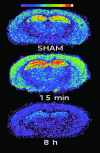Dynamic changes in N-methyl-D-aspartate receptors after closed head injury in mice: Implications for treatment of neurological and cognitive deficits
- PMID: 15044697
- PMCID: PMC387383
- DOI: 10.1073/pnas.0305741101
Dynamic changes in N-methyl-D-aspartate receptors after closed head injury in mice: Implications for treatment of neurological and cognitive deficits
Abstract
Traumatic brain injury is a leading cause of mortality and morbidity among young people. For the last couple of decades, it was believed that excess stimulation of brain receptors for the excitatory neurotransmitter glutamate was a major cause of delayed neuronal death after head injury, and several major clinical trials in severely head injured patients used blockers of the glutamate N-methyl-D-aspartate (NMDA) receptor. All of these trials failed to show efficacy. Using a mouse model of traumatic brain injury and quantitative autoradiography of the activity-dependent NMDA receptor antagonist MK801, we show that hyperactivation of glutamate NMDA receptors after injury is short-lived (<1 h) and is followed by a profound and long-lasting (> or =7 days) loss of function. Furthermore, stimulation of NMDA receptors by NMDA 24 and 48 h postinjury produced a significant attenuation of neurological deficits (blocked by coadministration of MK801) and restored cognitive performance 14 days postinjury. These results provide the underlying mechanism for the well known but heretofore unexplained short therapeutic window of glutamate antagonists after brain injury and support a pharmacological intervention with a relatively long (> or =24 h) time window easily attainable for treatment of human accidental head injury.
Figures



References
-
- Waxweiler, R. J, Thurman, D., Sniezek, J., Sosin, D. & O'Neil, J. (1995) J. Neurotrauma 12, 509-516. - PubMed
-
- Benveniste, H., Drejer, J., Schousboe, A. & Diemer, N. H. (1984) J. Neurochem. 43, 1369-1374. - PubMed
-
- Nilsson, P., Hillered, L., Ponten, U. & Ungerstedt, U. (1990) J. Cereb. Blood Flow Metab. 10, 631-637. - PubMed
-
- Schuhmann, M. U., Stiller, D., Skardelly, M., Bernarding, J., Klinge, P. M., Samii, A., Samii, M. & Brinker, T. (2003) J. Neurotrauma 20, 725-743. - PubMed
-
- Bullock, R., Zauner, A., Myseros, J. S., Marmarou, A., Woodward, J. J. & Young, H. F. (1995) Ann. N.Y. Acad. Sci. 765, 290-297. - PubMed
Publication types
MeSH terms
Substances
LinkOut - more resources
Full Text Sources
Other Literature Sources

